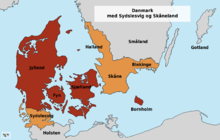Southern Schleswig




Southern Schleswig (
Ejderen. Prussian chancellor Otto von Bismarck concluded that this justified a war, and even proclaimed it a "holy war". He also turned to the Emperor of Austria, Franz Joseph I of Austria for help. A similar war in 1848 had gone poorly for the Prussians. With Prussia's modern weapons and the help from both the Austrians and General Moltke, the Danish army was destroyed or forced to make a disorderly retreat. The Prussian-Danish border was then moved from the Elbe up in Jutland
to the Kongeåen creek.
After the
The northern part reverted to Denmark as Nordslesvig (North Slesvig). But the middle and southern part, including Schleswig's only city,Federal Republic of Germany (West Germany
) in 1948.
History
The Schleswig lands north of the Eider river and the Bay of Kiel had been a fief of the Danish Crown since the Early Middle Ages. The southern Holstein region belonged to Francia and later to the Holy Roman Empire, but it was held as an imperial fief by the Danish kings since the 1460 Treaty of Ribe.[7]
The
Schleswig-Holstein Question was first brought to a head during the Revolutions of 1848, when, from 1848 to 1851, revolting German-speaking National liberals backed by Prussia fought for the separation of Schleswig and Holstein from Denmark in the First Schleswig War. Though the status quo ante bellum was restored, the conflict lingered on, and on 1 February 1864 Prussian and Austrian troops crossed the Eider, sparking off the Second Schleswig War, after which Denmark had to cede Schleswig and Holstein according to the Treaty of Vienna. After the Austro-Prussian War of 1866, victorious Prussia took control over all Schleswig and Holstein but was obliged by the Peace of Prague to hold a referendum in predominantly Danish-speaking Northern Schleswig, which it never did.[8]
After the German defeat in
Schleswig Plebiscites were decreed by the 1919 Treaty of Versailles, in which the present-day German-Danish border was drawn. The border took effect on 15 June 1920, dividing Schleswig into a southern and northern part and leaving a considerable Danish and German minority on both sides.[9][10]
Modern day
Southern Schleswig is part of the German
urban district (Kreisfreie Stadt) of Flensburg and the northern part of Rendsburg-Eckernförde (former district of Eckernförde plus the historic Hohner Harde
).

Besides Standard German,
electoral threshold
. Many of the last names found in the region are very often of Scandinavian or Danish form, with the -sen endings like Petersen.
The major cities of Southern Schleswig are
Schleswig, Eckernförde and Husum
.
See also
Bibliography
- Lars Henningsen: Sydslesvigs danske historie, Flensborg 2013.
- Lars Henningsen: Zwischen Grenzkonflikt und Grenzfrieden, Flensburg 2011 (as pdf document)
- Karen Margrethe Pedersen: Dansk sprog i Sydslesvig: det danske sprogs status inden for det danske mindretal i Sydslesvig, Institut for grænseregionsforskning Aabenraa 2000
References
- ^ Kathrin Sinner: Schleswig-Holstein - das nördliche Bundesland: Räumliche Verortung als kulturelles Identitäskonstruk, page 86
- ^ Sønderjylland A-Å, Aabenraa 2011, page 364
- ^ [email protected] (13 April 2018). "Vis". danmarkshistorien.dk.
{{cite web}}: CS1 maint: numeric names: authors list (link) - ^ German, Troels Fink: "Geschichte des schleswigschen Grenzlandes" Publisher: Munksgaard, Copenhagen 1958, pages 178-192.
- ^ "Påskekrisen 1920: HISTORIEFAGET". Archived from the original on 2016-05-07. Retrieved 2016-04-08.
- ^ "Påskekrisen 1920 - Gyldendal - Den Store Danske". denstoredanske.dk.
- ^ "Region Sønderjylland-Schleswig: Politische Entwicklungen im Mittelalter".
- ^ "Region Sønderjylland-Schleswig: Nationale Entwicklung im 19. Jahrhundert {{in lang|de}}".
- ^ "vimu - Det Virtuelle Museum: Genforening {{in lang|da}}".
- ^ "vimu - Das Virtuelle Museum: Volksabstimmung {{in lang|de}}".
- ^ "Region Sønderjylland-Schleswig: Sprachen und Dialekte südlich der Grenze{{in lang|de}}".
